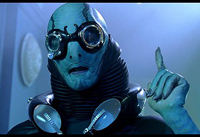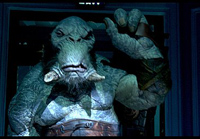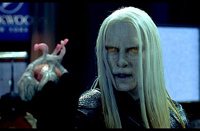Is the human race worth saving?
That’s the unanswered question looming in the background of Hellboy II: The Golden Army, Guillermo del Toro’s sprawling, take-no-prisoners follow-up to his comparatively timid first stab at Mike Mignola’s unconventional comic book superhero four years ago.
The red-skinned, cigar-chomping Hellboy (Ron Perlman) is still a demon fighting on the side of the angels, alongside pyrokinetic girlfriend Liz Sherman (Selma Blair), amphibious empath Abe Sapien (Doug Jones) and their colleagues at the Bureau for Paranormal Research and Defense. But does an ungrateful, greedy world deserve their efforts? Given a choice between heroism and happiness, between saving the world and saving one’s beloved, will self-interest always win out?
Amid a welter of eye-popping creature-feature smackdowns and stunning visions of grotesquerie, Hellboy II finds time to toy with questions like these. If Hellboy II is a Middle Movie, as it seems to be, answers may or may not be forthcoming in Hellboy III.
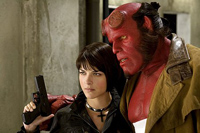
Ironically, it’s Christmas Eve as Hellboy II opens in a prologue set in 1955, when Hellboy was but a little Hell-BOY (as opposed to the current fully-grown Hell-MAN) living with his adopted father Prof. Bruttenholm (John Hurt) at an army base. The season is a reminder that salvation has already come to mankind—though Hellboy, like many kids at Christmas, isn’t thinking about the Savior, but about that other fellow who comes at that time of year. And when he asks Bruttenholm to tell him a story before bed, the professor cracks open a big old book and reads a mythic tale of primeval paradise lost—but it doesn’t bear much resemblance to the early chapters of Genesis.
In the beginning, the tale goes, men, elves and other supernatural creatures coexisted peacefully on earth. But man was “created with a hole in his heart,” and in his “infinite greed” sought to overrun the earth. This led to war between men and faeryfolk, and to the creation of the unstoppable Golden Army—a force so terrible that the wise Woodland King decided it must never be used, and struck a treaty with man to share the earth, with cities for men and forests for creatures of faery.
Meanwhile, untold millennia later in the real world, it turns out that creatures of magic have gotten the short end of the stick, having kept their end of the treaty while humans blithely did as they pleased. The aged Woodland King accepts this with passive resignation, reasoning that it is their nature to keep the treaty just as it is man’s nature to break it.
However, exiled Prince Nuada (Luke Goss, One Night With the King) isn’t content to fade away while man bulldozes forests to build shopping malls. Nuada wants total war, Golden Army–style—and he’s willing to kill his own kind to get things started. The main hitch: His twin sister Princess Nuala (Anna Walton, Vampire Diary) flees with of the three pieces of the magical crown needed to control the Golden Army.
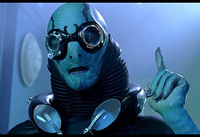
That’s the setup to an ever-escalating battery of showdowns including a bloody coup in faeryland, attacks by swarms of disturbingly feral fairies, a melee in an underground troll market, a sprawling combat with an enormous vegetative forest god in the shadow of the Brooklyn Bridge, and of course a climactic confrontation with Nuada and the Golden Army.
First and foremost, Hellboy II is a riot of creature and set design as well as outsize action set pieces. What makes this stuff work especially well is Del Toro’s penchant for props and prosthetics rather than overreliance on computer graphics.
The troll market is like Diagon Alley crossed with the Mos Eisley Cantina, but bigger and more convincing than either. A disturbing figure called the “Angel of Death” strikingly echoes a couple of the more startling images from Del Toro’s Pan’s Labyrinth while also offering a dark take on the six-winged, many-eyed angels of Isaiah and Revelation. The climactic battle, set in an enormous chamber of giant clockwork gears, is compared by stunt coordinator Brad Allan to Chaplin’s Modern Times and Jackie Chan. However, I was reminded of the climactic clock-tower battle in Miyazaki’s The Castle of Cagliostro as well as the “killing floor” duel at the climax of William Gibson’s short story Johnny Mnemonic.
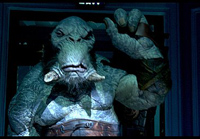
At the same time, Del Toro never reduces the characters to mere action figures. Not that character development is high on the movie’s priorities, but the personalities and relationships remain at the fore: Hellboy’s hard-boiled, blue-collar nonchalance and stoic apprehension about his relationship with Liz; Liz’s wounded caution and anxiety over the secret she has not told Hellboy; Abe’s diffidence, intellectual curiosity and unexpected affinity for fellow empath Nuala.
As with Peter and MJ in the Spider-Man movies, romance in Hellboy II is a driving force rather than a side dish, and impacts the action as well as creating its own set pieces. There’s a hilariously offbeat Manilow Moment reminiscent of the goofy 1970s musical interludes from the latter two Spider-Man movies—and, when the end credits reprise the song, it seems to suggest that really this is what it’s all about.
Then again, the sort of bond celebrated in the song can have good or bad implications. In fact, the lyrics could just as well describe the dangerous mystic connection between Nuala and Nuada as the emotions of the lovers. Then, too, there’s the question whether love conflicts or competes with duty and heroism, or reaffirms them. The Spider-Man movies struggled with the first possibility before embracing the second. The Hellboy franchise hasn’t gotten there yet.
Most recent comic-book movies involve a love story; Hellboy II ups the ante by adding a pregnancy—a theme Del Toro playfully drives home by including a gigantic, swollen stone fertility goddess, which plays an unexpected role in one of the early set pieces. There’s also a strange bit of set design in the Brooklyn Bridge street sequence, which repeatedly depicts, on one side the street, a lit-up storefront church cross, and on the other a marquee with what seems to be a cryptic code phrase for one of the most objectionable slang terms for female anatomy.

In the original Hellboy, the villains were adversaries like demons, Nazis, gods of chaos, assassins and necromancers—characters understood to be evil more or less by nature or by definition, like orcs, vampires or witches. Hellboy II shifts from this kind of mythic good-vs-evil storytelling to something more like classical mythology, with variously flawed characters on all sides.
Except for an occasional cross or rosary, the vestigial Christian influence from Hellboy is virtually gone here. In its place is something a lot like a work of pagan imagination, at times partially reminiscent of the worlds of Japanese animation master Hayao Miyazaki, with his ambiguous antagonists and animistic spirit-creatures.
This isn’t simply a bad thing. Good-vs-evil storytelling aptly reflects the black-and-white world of spiritual warfare, but conflicts in the visible world are seldom so clear-cut. Even Nazis aren’t really pure evil like demons, though movies and comic books might treat them as such. Most people who do bad or even horrible things are more like the denizens of the troll market than typical movie monsters—more interested in going about their business than making life miserable for other people.
Del Toro has fleshed out the villainy of the villains. What he still hasn’t fleshed out is the heroism of the heroes—their humanity, yes, but not their heroism. Two films into the Hellboy franchise, what is still missing is redemption—a crucial theme, as Roger Ebert noted this week on his blog.
I believe Hellboy and his allies are tough and fearless enough to fight and win and save the day. I don’t yet know—and I’m not sure they know—what they fight for, what they believe in, what in their world is worth saving.
Here’s hoping Hellboy III finds some answers.
Talk About It
Discussion starters- How problematic is the notion of a “good demon” in a comic-book story? Consider the notion of a “good witch” like Glinda in The Wizard of Oz. How are they these the same? How are they different?
- What might it mean to say that man was “created with a hole in his heart”? Is there more than one way to interpret this statement? In what sense might it be true? In what sense might it be false?
- What does pregnancy mean for an unmarried couple? What should such a couple do? How is it different for a married couple?
- Can you imagine being offered a choice like the one the Angel of Death offers Liz? Do you think her choice is defensible or not? Why or why not? What do you think you would do?
The Family Corner
For parents to considerHellboy II is rated PG-13 for “sequences of sci-fi action and violence, and some language.” The film is replete with vividly imagined, often disturbing creatures and much intense, sometimes frightening action violence. There is some crude language, and a few possible instances of God’s name taken in vain a couple of times. A key plot point turns on Hellboy and Liz’s nonmarital cohabitation, and a passing media reference to public criticism of their “interspecies relationship” amounts to a satiric jab at opposition to same-sex “marriage.” There’s also a scene in which Hellboy and Abe become semi-inebriated (Abe first resists, saying, “My body is a temple,” to which Hellboy responds, “Mine’s an amusement park”).
Photos © Copyright Universal
Copyright © 2008 Christianity Today. Click for reprint information.


